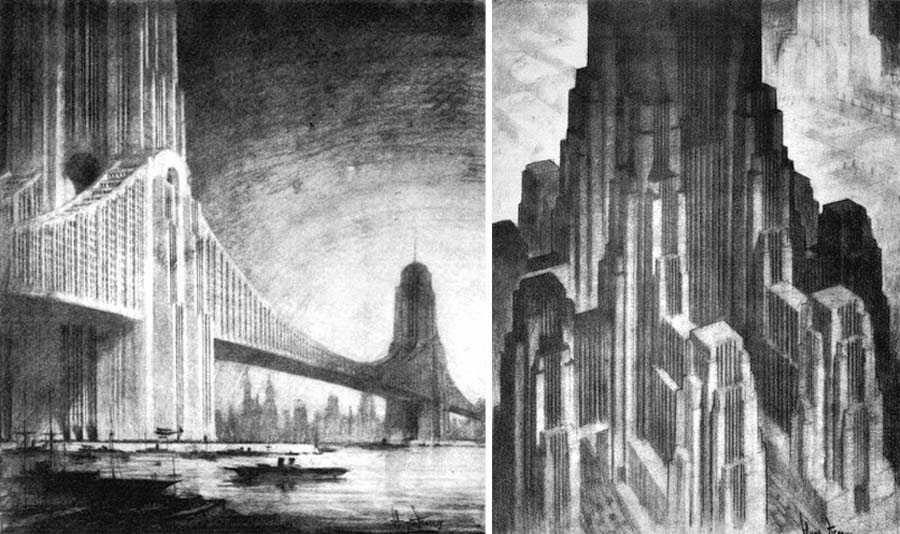 "QUANTUM SHOT" #328(rev) "QUANTUM SHOT" #328(rev) Link - article by Avi Abrams When living in mega-cities was considered a privilege... See that gleaming Metropolis on the horizon? - these majestic towers were something to aspire to, to dream about, to shape your life accordingly in an effort to reach it, and finally attain it as the ultimate reward... Such ideas were popular during the infant days of futurism in the 1920s, then in fantastic literature on both sides of the Atlantic during the Golden Age of Wonder in the 1930s, until finally, these grandiose visions fizzled out sometime in the 1980s together with the general decline of futurism.  (image credit: art by Robert McCall, 1970s, via) Thankfully, this "mega-urbanism" dream has been largely replaced today with the pastoral idea of affluent living in a neatly-maintained countryside - but frankly, both concepts seem pretty unattainable today, turning out to be the clean-cut ideals that are only pretty to look at. And look at them we will - presenting again (read our previous futuristic outing "Retro Future To The Stars") the rarely-seen examples of urbanism and architecture, found in the Eastern Bloc "popular science" publications and promotional literature, as well as in little-known Western pulp magazines.  (image source: "Tekhnika Molodezhi", 1967, Russia)  (illustration to the science fiction book by A. Kazantsev, 1939-1956, Russia)  (legendary Golden Age science fiction art by Frank R. Paul, 1933) The Dark Monumentality of Hugh Ferriss' Gotham Style First, let us cover the basics, perhaps the most influential early work of futuristic urbanism. This whole "Gotham/Empire" 1930s style in architecture (that we know so well from "Batman" and "Dark City" movies) really took off after the publication of conceptual work by High Ferriss in 1929. His book "The Metropolis of Tomorrow" impressed the whole generation of architects with its moody, colossal projections, and dark monolithic edifices destined to haunt the dreams of would-be dictators and (perhaps even) power-mad superheroes:     (images credit: art by Hugh Ferriss, the Avery Collection, via) Skyscraper Canyons as The Reflection of the Power of Totalitarian State Such mega-urbanism and colossal architectural dreams that were prevalent in 1920s and 1930s, in my opinion, reflect the general society's drift toward collective ideals at that time in history. You could almost hear people chanting "All Hail the Empire!" - any empire - ideally ruled by (one can only hope) benevolent tyrant and powered by some mind-boggling feats of technology. The life of an individual human being, revealed in these visions, would be indeed microscopic, disposable and insignificant, as seen against the backdrop of the titanic activity of the masses.  Skyscraper canyons of all sorts were obligatory part of urban visions from the 1920s and 1930s, here are some shots from the Fritz Lang's famous "Metropolis" movie, 1927, and also from the Futurama set for the 1930 movie "Just Imagine":     (images from Futurama and the "Just Imagine" movie, info) More modern and abstract vision (but just as scary in its soul-less uniformity) is this wonderful art by Ryan Bliss, DigitalBlasphemy:  (image credit: Ryan Bliss, DigitalBlasphemy) People's Palaces of Socialist-Envisioned Bliss The Soviets had similarly gigantic aspirations in architecture, as demonstrated by the well-known Palace of the Soviets design (read our articles about Totalitarian Architecture of the Soviet Union and Totalitarian Architecture of the Third Reich for even more odious examples):  (image source: "Tekhnika Molodezhi" cover, 1952, Russia; right image via) The Lenin's statue was proposed to be built on a truly grandiose scale:  Large-scale architectural dreams and the similarly epic conquest of space are combined in this highly evocative Communist cover from 1954:  ("Tekhnika Molodezhi", 1954, Russia) The next image clearly shows that America had a very strange conception of Soviet architectural ambitions during the Cold War:  The Soviets, however, dreamed large:   (images source: "Tekhnika Molodezhi", 1967-1970, Russia) Note the soaring super-highways, which were definitely very important elements of urban transportation visions in the 1950s-1970s:  (image credit: art by Syd Mead, from his book "Sentinel", via)  (image credit: art by Klaus Burgle, Germany) Some of the EXPO pavilion designs were pretty futuristic for the 1960s, for example this US Pavilion on the left:  (images via) Here is an interesting concept for parking: rotating hexagonal cells house one car each, plus the whole thing rotates like a "Russian Roulette" Revolver:  (source: TM, 1975, Russia) Here are the "Flying Cities in the Clouds of Venus", as envisioned by Russians in 1971:  (source: TM, 1971, Russia) Many rosy visions of futuristic urbanism can be found in the Western pulp and promotional literature:  (image credit: art by Klaus Burgle, Germany)  (image credit: art by James R. Powers, via Plan59)  (concept art by Arthur C. Radebaugh) Here is a great illustration by Joe Tillotson to the story "Robot: Unwanted" by Daniel Keyes ("Other Worlds", June 1952) -  "Bubble Cities" were a notable feature of the 1950s science fiction:  (left: "Urania" science fiction magazine cover, 1959, Italy) Futuristic Interiors Par Excellence So what's inside these cool apartments of the future? Have a peek at the "totally rad" and psychedelic Sixties-style interiors by Danish designer Verner Panton:  (images credit: Verner Panton, via) As you can see, urbanism turned out to be quite a different proposition from what we imagined seventy years ago. Of course, there are numerous reasons to stay away from the soul-destroying mega-city projects, and we are glad this trend did not catch on. Overpopulation, however, dictates its own rules, and it seems we are going to see many gargantuan super-structures to be built in the world in the coming years. Perhaps we'll even see the visions of Frank R. Paul's 1930s Mega-City come to life, after all? Article by Avi Abrams, Dark Roasted Blend. CONTINUE TO THE NEXT PART! -> READ THE FIRST PART HERE
|
Wednesday
Retro-Future: Glorious Urbanism
Posted by
Unknown





